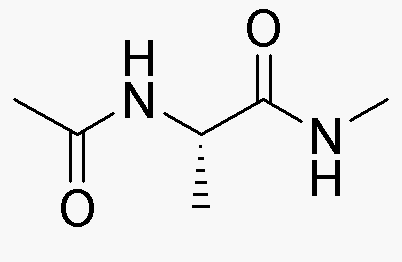Acetyl-L-alanine methyl amide is widely utilized in research focused on:
- Peptide Synthesis: This compound serves as a building block in the synthesis of peptides, which are essential in drug development and biochemistry.
- Neuroscience Research: It is used in studies investigating neurotransmitter functions, aiding in the understanding of neurological disorders.
- Protein Structure Analysis: Researchers employ it to stabilize protein structures, enhancing the accuracy of structural biology studies.
- Drug Formulation: Its properties make it useful in formulating pharmaceuticals, particularly in improving the solubility and bioavailability of active ingredients.
- Cosmetic Applications: The compound is also explored in cosmetic formulations for its potential benefits in skin health, offering moisturizing and anti-aging properties.
General Information
Properties
Safety and Regulations
Applications
Acetyl-L-alanine methyl amide is widely utilized in research focused on:
- Peptide Synthesis: This compound serves as a building block in the synthesis of peptides, which are essential in drug development and biochemistry.
- Neuroscience Research: It is used in studies investigating neurotransmitter functions, aiding in the understanding of neurological disorders.
- Protein Structure Analysis: Researchers employ it to stabilize protein structures, enhancing the accuracy of structural biology studies.
- Drug Formulation: Its properties make it useful in formulating pharmaceuticals, particularly in improving the solubility and bioavailability of active ingredients.
- Cosmetic Applications: The compound is also explored in cosmetic formulations for its potential benefits in skin health, offering moisturizing and anti-aging properties.
Documents
Safety Data Sheets (SDS)
The SDS provides comprehensive safety information on handling, storage, and disposal of the product.
Product Specification (PS)
The PS provides a comprehensive breakdown of the product’s properties, including chemical composition, physical state, purity, and storage requirements. It also details acceptable quality ranges and the product's intended applications.
Certificates of Analysis (COA)
Search for Certificates of Analysis (COA) by entering the products Lot Number. Lot and Batch Numbers can be found on a product’s label following the words ‘Lot’ or ‘Batch’.
Número de catálogo
Número de lote/lote
Certificates Of Origin (COO)
This COO confirms the country where the product was manufactured, and also details the materials and components used in it and whether it is derived from natural, synthetic, or other specific sources. This certificate may be required for customs, trade, and regulatory compliance.
Número de catálogo
Número de lote/lote
Safety Data Sheets (SDS)
The SDS provides comprehensive safety information on handling, storage, and disposal of the product.
DownloadProduct Specification (PS)
The PS provides a comprehensive breakdown of the product’s properties, including chemical composition, physical state, purity, and storage requirements. It also details acceptable quality ranges and the product's intended applications.
DownloadCertificates of Analysis (COA)
Search for Certificates of Analysis (COA) by entering the products Lot Number. Lot and Batch Numbers can be found on a product’s label following the words ‘Lot’ or ‘Batch’.
Número de catálogo
Número de lote/lote
Certificates Of Origin (COO)
This COO confirms the country where the product was manufactured, and also details the materials and components used in it and whether it is derived from natural, synthetic, or other specific sources. This certificate may be required for customs, trade, and regulatory compliance.


